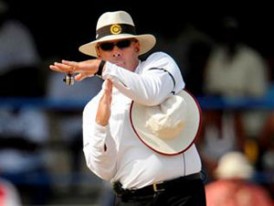DRS : A middle ground
Ganeshbabu Venkat |
After a weekend of watching cricket, it is that time of the year where I’m compelled to write a piece on DRS. There were two incidents that got my cricketing gears grinding. First, In the India-Australia Test, when Michael Clarke was erroneously adjudged, not out on 39, and he went on to score a century. Second, In the West Indies- Zimbabwe One-dayer, West Indian umpire Peter Nero made the cardinal error of not referring a run out. Ramnaresh Sarwan was a good six inches short of the crease and needless to mention he completed a ton and took West Indies to a series victory.
I’m an ardent proponent of the DRS; the original intent of the DRS as told by the ICC was to eradicate the howler.Both Sarwan’s and Clarke’s were howlers of epic proportions.It was clear during the live play and the replays that Clarke inside-edged the ball to the short-leg fielder and Sarwan was well short of the crease when the stumps were broken. Both these could have been corrected with a few tweaks to the system.
The main issue that needs to be addressed is to create a system in place that is consistent across the board. Fundamental errors like these could be fixed easily with a bare bones system devoid of hawkeye, predictive path and the hotspot. The primary opponent of the DRS in its current form has been the BCCI. BCCI’s main problem has been their lack of confidence in predictive path and the hot spot cameras. The reason people are able to pounce on the BCCI is because they have not been able to articulate their reservations to the public clearly. As much as the BCCI are to be blamed, the other cricket boards also have failed in their duty by not standing up to the BCCI; we have not seen a single board proposing a viable solution to this mess.
A practical solution would be to eliminate all the contentious pieces from DRS and keep the referral process straight forward. My proposal is if a batsman is declared out LBW, He can appeal the decision only for two things. One, if he thinks he has an inside edge and two if he thinks the ball pitched outside the leg stump. Vice versa, the fielding side can ask for a referral if they think there is no inside edge or they think the ball pitched within the stumps. The hawk eye predictive path should be completely kept out of the process.
Catches can be referred based on what a conventional replay can establish than relying upon hot spot, which has proved to be unreliable on many occasions. The number of referrals for a team should be increased to three. In addition, if there is a blatant howler that is missed by both the players and the umpires, the third umpire should intervene and assist the on-field umpire in making the right call. This will eliminate players referring marginal calls, hoping against hope that the decision would be reversed.
In essence, the referrals will be used only for inside edges, balls pitching outside leg stump for LBW’s and catches that can be established by a replay without hotspot or snicko-meter. If an umpire makes a marginal call based on height, ball hitting outside the line and nicks they will still remain as is and cannot be referred. Many people will not support eliminating hot spot from the DRS equation, Nevertheless If that brings in a system that is acceptable for all it should be adopted for the greater good. ICC in their quest to get a 100% accuracy rate on all decisions is ruining the game by having different set of rules for a different set of matches.
The bare bones approach will not get to the 100% rate, but will certainly get close to that magical mark which is better than not having the DRS at all for certain matches. DRS is a fantastic tool, and if tuned properly, it will certainly improve the quality of decisions and make cricket viewing a more pleasurable experience for the paying public.





Leave a comment